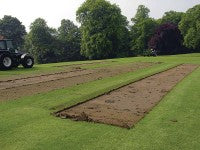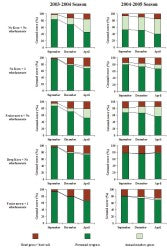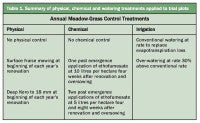A turn of fraise
 The control of Annual Meadow-Grass on professional football pitches
The control of Annual Meadow-Grass on professional football pitches
Football pitches are usually sown with perennial ryegrass as the dominant grass species due to its hard-wearing nature and favourable playing characteristics. However, it is not long before light green patches of annual meadow-grass can be seen in the sward. Indeed, in as little as three years after construction, it can be the dominant grass species on a pitch. As such, the spread of annual meadow-grass on newly constructed football pitches continues to be a common and persistent problem.
Annual meadow-grass, despite being a species which is tolerant of heavy wear, does have a number of undesirable characteristics. These include a tendency to 'kick out' in the form of divots, the unsightly patchy nature of the sward, it is susceptible to Microdochium patch disease and it can be associated with the formation of a thatchy surface layer which can affect playing quality.
The rate of annual meadow-grass spread depends on pitch usage levels, management and renovation practices. In the past, it has been controlled using both physical (e.g. scarification) and chemical (herbicide) techniques. Physical control has been based on cleaning the surface as much as possible during the renovation process, before sowing with the desired species. Chemical control has been hindered by: a) finding selective herbicides that do not damage the other grass species in the sward; and b) the ever-decreasing number of permitted herbicides.
The trial
With support from the Professional Football Association and Campey Turf Care Systems an experimental trial has been carried out at the STRI over three football playing seasons. The objective was to investigate the relative effectiveness of mechanical and chemical treatments to control the spread of annual meadow-grass on football pitches.
At the end of each playing season the trial area was renovated and oversown, then, after the grass had germinated, chemical treatments were applied. The trial was based at the STRI trials ground where an area was prepared using a sand-dominated rootzone similar to that at many professional football clubs.
The area had been used in the past for other trials, therefore it was likely that there was a significant seed bank of annual meadow-grass present. In addition, material from annual meadow-grass infected rootzone cores was spread over the area. The trial was sown with a mixture of three perennial ryegrass cultivars.
Three sets of treatments were included as outlined in Table 1. The physical treatment consisted of the preparation and renovation of the soil using a Koro Fieldtopmaker, which has a series of rotating blades and has the ability to remove arising debris using a conveyor system. The fraise mowing treatment comprised removing the herbage from the top of the pitch, whilst the deeper treatment went down to a depth of 18mm, thereby removing the vegetation and the immediate surface layer. The material removed by the deeper Koro treatment was replaced using a matching sand-dominated rootzone.
The chemical treatments consisted of applications of the herbicide ethofumesate, which has proven to be effective at controlling annual meadow-grass on sports turf. Both applications involved the post-emergence spraying with ethofumesate following renovation and oversowing, with one using a single application of 10 litres per hectare after four weeks whilst the other consisted of two applications, four and eight weeks, at an application rate of 5 litres per hectare. The ethofumesate applied was Stefes Fumat 2 (200g/l, 21% w/w, Ethofumesate) and, for the following year, Nortron Flo (500g/l, 44.3% w/w, Ethofumesate), both applied at an equivalent rate.
In addition to the physical and chemical treatments, the effect of over-watering on the spread of annual meadow-grass was investigated. The individual plots received either conventional watering to replace evapotranspiration losses, using a Toro Trident irrigation controller, or were over-watered by 30% above the conventional irrigation rate.
Wear was applied during the football playing season, twice a week using a differential slip wear machine. The aim was to simulate grass cover loss through the central areas of a pitch.
The botanical composition of the plots was recorded three times during each football season. Assessments of total live cover of the plots were recorded on four occasions during each playing season. Additional measurements were made on playing quality, including ball rebound, hardness and traction.
Trial results
Over-watering
Initially, the amount of annual meadow-grass in the sward at the start of the trial was low at around 1-2%. By the beginning of the second season annual meadow-grass had risen to nearly 20% for the over-watered treatment as compared to 14% for the conventionally watered plots. The amount of annual meadow-grass increased to around 45% for both watering treatments at the beginning of the third season, after the summer watering period.
Chemical control
The use of ethofumesate was effective at reducing the proportion of annual meadow-grass in the sward (Figure 1). The amount of annual meadow-grass was low for all treatments during the first playing season (data not shown). However, during the subsequent two seasons the annual meadow-grass, as a proportion of the live grass cover, in the untreated control plots rose significantly to around 40% where it remained for the following playing season. Where ethofumesate was applied annual meadow-grass content remained below 5% of total live grass cover. There were no significant differences in the amount of annual meadow-grass between the two ethofumesate treatments.
It was noted that, after the first year of ethofumesate applications, the two 5 litre per hectare treatment appeared to have a phytotoxic effect on the perennial ryegrass, the proportion of perennial ryegrass dropping to 66%, with the amount of bare ground and dead grass reaching 34%. This effect was not seen in those plots treated with only one ethofumesate application or for either treatment in the two following seasons. No reason has been identified to explain the phytotoxicity on the perennial ryegrass on this single occasion.
Physical control
 Both Koro treatments reduced the proportion of annual meadow-grass in the live grass cover. The deep Koro treatment consistently kept the annual meadow-grass content below 5%, whereas this figure rose to nearly 30% in the fraise mown treatments at the end of the playing season. The proportion of dead grass and bare ground in the physical control treatments was generally similar to the plots treated with ethofumesate.
Both Koro treatments reduced the proportion of annual meadow-grass in the live grass cover. The deep Koro treatment consistently kept the annual meadow-grass content below 5%, whereas this figure rose to nearly 30% in the fraise mown treatments at the end of the playing season. The proportion of dead grass and bare ground in the physical control treatments was generally similar to the plots treated with ethofumesate.
Both physical treatments affected the playing characteristics of the surface. In 2004-05, following two sets of pitch renovation, hardness and ball rebound values were significantly lower for the non Koro treatments than for the deep Koro and fraise mown plots. This was almost certainly the result of the build up organic matter at the surface on the untreated control plots. Traction, a measure of the amount of grip available to the player, was also found to be significantly greater in the fraise mown plots during the last playing season as compared to the non Koro treatment.
Conclusions
The main findings from this trial are:
• Both the chemical and physical control techniques used in this research were effective at controlling the amount of annual meadow-grass in the sward.
• Chemical control kept annual meadow-grass content below 5%, although plots treated with ethofumesate did suffer a greater proportion of grass cover loss as compared to the physical treatments.
• There was no difference between using one or two post emergent applications of ethofumesate.
• Both the fraise mowing and deeper Koro treatments had lower annual meadow-grass contents than treatments with no control. The deeper Koro treatment constantly kept the abundance of annual meadow-grass below 2%. However, it involved removing the top 18mm of rootzone, which had to be replaced every year. So, on a large area would be time consuming and more costly.
• The over-watering treatment led to increased annual meadow-grass content, therefore the correct watering regime is vital for maintaining professional football pitches with low annual meadow-grass contents. Excessively wet conditions allow annual meadow-grass to spread more rapidly and out-compete the perennial ryegrass.
• Without control annual meadow-grass abundance increased to around 50% of the live grass cover, and was the dominant species after only two playing seasons.
Click on images to enlarge
